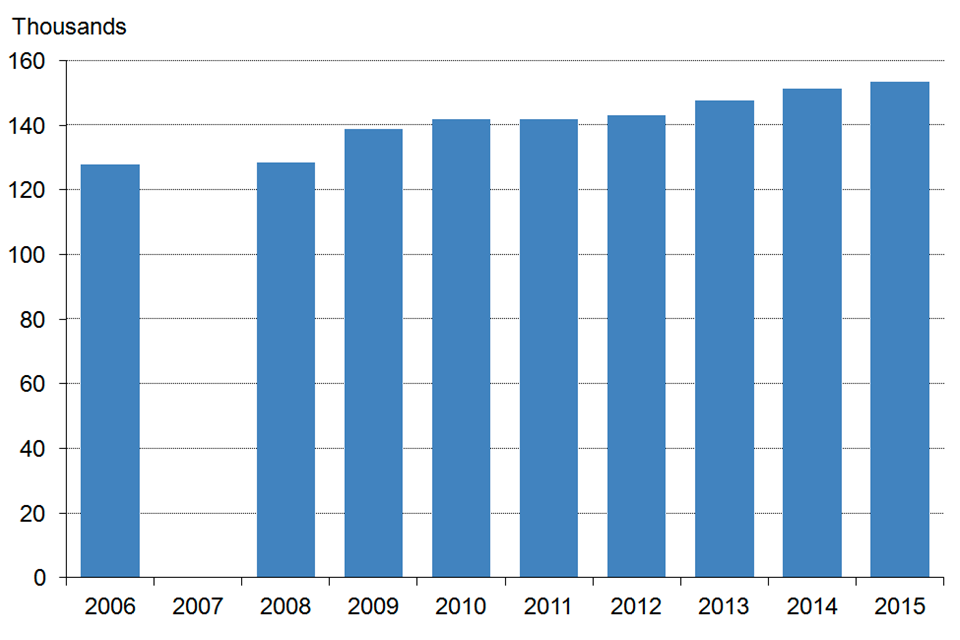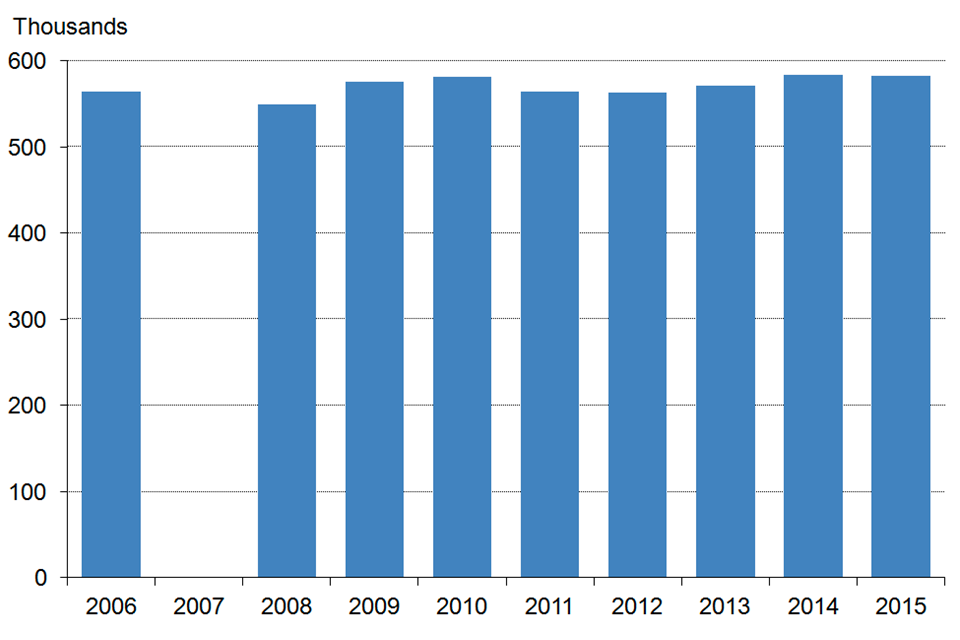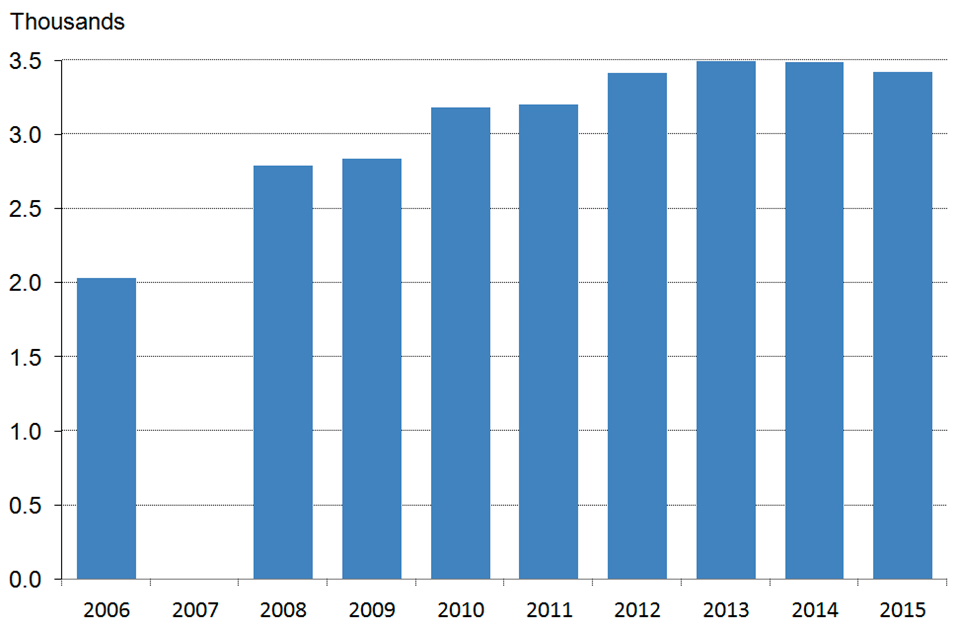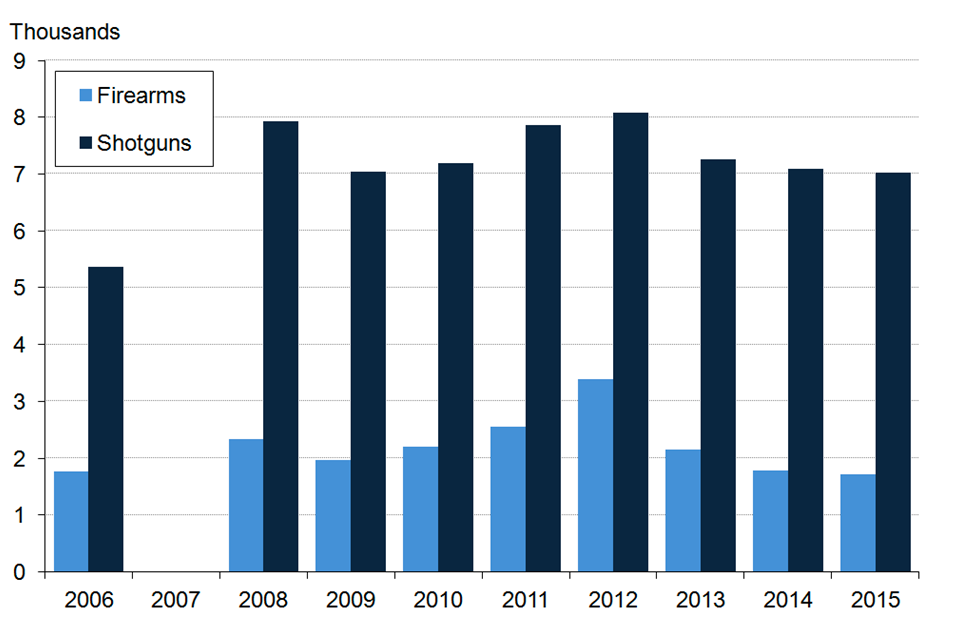Firearm and shotgun certificates in England and Wales financial year ending March 2015
Published 24 September 2015
Applies to England and Wales
1. Introduction
Information is presented here on firearm and shotgun certificates issued by police forces in England and Wales under the Firearms Acts 1968 to 1997. It covers certificates on issue as at 31 March 2015, as well as historical trend data and police force comparisons. The statistical release also provides information on the number of certificates granted and refused for new and renewal applications, certificates revoked, registered firearm dealers, visitors’ permits, European firearm passes (EFP) and Article 7 Authorities issued.
The data were extracted on 31 March 2015 from the National Firearms Licensing Management System (NFLMS), which is a register of all persons who have applied for a certificate to possess or acquire a firearm or shotgun.
The user guide provides additional information on the release. It includes a glossary and information on the conventions used in the statistics, legislation and regulations, and data coverage.
No forces made revisions to any of their data for previous years. The data for the latest year (and for other years) may be revised in due course. It is standard practice across all Home Office statistical releases to incorporate revisions for previous years’ data in the latest release. Corrections and revisions follow the Home Office corporate revisions policy (see page 6).
2. Summary
Firearm certificates
- there were 153,603 firearm certificates on issue as at 31 March 2015, an increase of 1.4% (2,190) compared with the previous year’s figure, and the highest number since 1988
- there were 525,125 firearms covered by such certificates, an increase of 3.4% (17,258) compared with the previous year’s figure, and the highest number since these figures first became available in 1995
- there were 9,053 new firearm certificate applications granted in the year to 31 March 2015, an increase of 1.4% (123) compared with the previous year’s figure
- of the new applications for firearm certificates in the year to 31 March 2015 (9,241), 2.0% (188) were refused, this compares with 1.5% (140) which were refused in the previous year
- a total of 406 firearm certificates were revoked in the year to 31 March 2015, an increase of 1.0% (4) compared with the previous year’s figure
- there were 3,422 registered firearm dealers as at 31 March 2015, a decrease of 1.8% (-64) compared with the previous year’s figure; the number of firearm dealers also includes any business that sells or transfers shotguns
Shotgun certificates
- there were 582,494 shotgun certificates on issue as at 31 March 2015, a decrease of 0.1% (-429) compared with the previous year’s figure
- there were 1,338,399 shotguns covered by such certificates, an increase of 0.7% (9,023) compared with the previous year’s figure and the highest number since the year ending 31 March 2010
- there were 21,438 new shotgun certificate applications granted in the year to 31 March 2015, a decrease of 9.5% (-2,242) compared with the previous year’s figure
- of the new applications for shotgun certificates in the year to 31 March 2015 (22,067), 2.9% (629) were refused; this compares with 2.8% (675) which were refused in the previous year
- a total of 1,373 shotgun certificates were revoked in the year to 31 March 2015, a decrease of 0.3% (-4) compared with the previous year’s figure
3. Firearm certificates
3.1 Number of firearm certificates on issue and firearms covered by such certificates
There were 153,603 firearm certificates (on issue) as at 31 March 2015, an increase of 1.4% (2,190) compared with the previous year’s figure and the highest number since 1988.
The number of firearm certificates declined overall from 190,600 as at 31 December 1971, which was soon after the introduction of the Firearms Act 1968, to 117,700 as at 31 December 2002, the series low. Since then, there has been an upward trend (apart from the slight fall as at 31 March 2011). The number of firearm certificates as at 31 March 2015 was 30.5% (35,903) higher than as at 31 December 2002.
Police forces with the highest number of firearms certificates as at 31 March 2015 were Devon and Cornwall, Sussex and West Mercia (10,855, 6,735 and 6,708 respectively) and police forces with the lowest number were City of London, Merseyside and Cleveland (3, 1,012 and 1,099 respectively). There were 525,125 firearms (covered by firearm certificates on issue), an increase of 3.4% (17,258) compared with the previous year’s figure, and the highest number since these figures first became available in 1995.
The number of firearms decreased from a high of 418,300 as at 31 December 1996 to 295,000 as at 31 December 1998, the series low. This corresponded with the tightening of gun control through the Firearms (Amendment) Act 1997, which was prompted by the Dunblane massacre. Since 31 December 1998, there has been an upward trend. The number of firearms as at 31 March 2015 was 78.0% higher (230,125) than as at 31 December 1998.
The number of firearms per 100,000 people (calculated using Office for National Statistics’ mid-2014 population estimates for England and Wales) as at 31 March 2015 was highest in North Yorkshire, Cumbria and Dyfed-Powys (2,506, 2,290 and 2,265 respectively). This pattern corresponds with police forces with the highest number of firearms/shotguns per 100,000 people tending to be in more rural areas, where the population is often lower and firearms/shotguns are more frequently used for employment (e.g. gamekeeping and farming) and leisure activities (e.g. target shooting and game shooting). Police forces with the lowest number of firearms per 100,000 people were City of London, Metropolitan Police Service and West Midlands (173, 201 and 296 respectively).
The average number of firearms per certificate as at 31 March 2015 was 3.4, the same ratio as the previous two years. The number of firearms per certificate decreased from 2.9 as at 31 December 1995 to 2.2 as at 31 December 1999. Since then, the ratio has gradually increased to 3.4 as at 31 March 2013 and has remained stable since.
Figure 1: Firearm certificates on issue, as at 31 March 2006 to 2015, England and Wales

Chart notes
1. Data as at 31 March 2007 are not available (see data quality section of user guide).
Source: Home Office, table 1.
3.2 New applications, renewals and revocations
There were 9,053 new firearm certificate applications granted in the year to 31 March 2015, an increase of 1.4% (123) compared with the previous year’s figure.
Of the new applications for firearm certificates in the year to 31 March 2015 (9,241), 2.0% (188) were refused. This compares with 1.5% (140) which were refused in the previous year and is the highest proportion since the year to 31 December 1990, when the proportion was also 2.0%.
There were 17,640 firearm certificate renewal applications in the year to 31 March 2015, of which 17,606 were granted and 34 (0.2%) were refused.
There has been a 5-year renewal cycle for firearm certificates since 1995, so it is not appropriate to compare year-on-year changes for renewals. Previously, it had been a 3-year renewal cycle (see user guide for further details)
Firearm certificates can be revoked if the chief police officer for the force concerned is satisfied that the holder can no longer be entrusted with firearms, according to the Firearms Act 1968. A total of 406 firearm certificates were revoked in the year to 31 March 2015, up slightly from 402 in the previous year.
4. Shotgun certificates
4.1 Number of shotgun certificates on issue and shotguns covered by such certificates
There were 582,494 shotgun certificates (on issue) as at 31 March 2015, a decrease of 0.1% (-429) compared with the previous year’s figure.
From as at 31 December 1971, the number of shotgun certificates rose, peaking at 882,000 as at 31 December 1988, before falling to 549,207 as at 31 March 2008, the series low. The number of shotgun certificates has fluctuated since but nonetheless the figure as at 31 March 2015 represents an increase of 6.1% (33,287) compared with the 31 March 2008 figure.
Police forces with the highest number of shotgun certificates as at 31 March 2015 were Devon and Cornwall, Thames Valley and West Mercia (31,720, 28,152 and 27,984 respectively) and police forces with the lowest number were City of London, Cleveland and Merseyside (28, 2,752 and 3,607 respectively).
There were 1,338,399 shotguns (covered by shotgun certificates on issue) as at 31 March 2015, an increase of 0.7% (9,023) compared with the previous year’s figure.
From as at 31 December 1995, when the figures were first available, the number of shotguns has been fairly stable, ranging from between 1.3 million and 1.4 million shotguns.
The number of shotguns covered by certificates on issue per 100,000 people (calculated using Office for National Statistics’ mid-2014 population estimates for England and Wales) as at 31 March 2015 was highest for Dyfed-Powys, Norfolk and Suffolk (6,998, 6,467 and 5,800 respectively). This pattern corresponds with police forces with the highest number of firearms/shotguns per 100,000 people tending to be in more rural areas, where the population is often lower and firearms/shotguns are more frequently used for employment (e.g., gamekeeping and farming) and leisure activities (e.g. clay shooting and game shooting). Police forces with the lowest number of shotguns per 100,000 people were Merseyside, Metropolitan Police Service and City of London (550, 585 and 632 respectively).
The average number of shotguns per certificate as at 31 March 2015 was 2.3, the same ratio as the previous year. The average number of shotguns per certificate has increased from 2.0 as at 31 December 1995 (when figures were first available) to 2.4 as at 31 December 2002 and has remained fairly stable since.
Figure 2: Shotgun certificates on issue, as at 31 March 2006 to 2015, England and Wales

Chart notes
1. Data as at 31 March 2007 are not available (see data quality section of user guide).
Source: Home Office, table 3.
4.2 New applications, renewals and revocations
There were 21,438 new shotgun certificate applications granted in the year to 31 March 2015, a 9.5% decrease (-2,242) compared with the previous year’s figure.
Of the new applications for shotgun certificates in the year to 31 March 2015 (22,067), 2.9% (629) certificates were refused. This compares with 2.8% (675) which were refused in the previous year and is the highest proportion of the series (figures first became available for the year to 31 December 1983).
There were 49,196 shotgun certificate renewal applications, of which 49,101 were granted and 95 (0.2%) were refused. As with firearm certificates, there has been a 5-year renewal cycle for shotgun certificates since 1995, so it is not appropriate to compare year-on-year changes. Previously, it had been a 3-year renewal cycle (see user guide for further details).
Shotgun certificates can be revoked if the chief police officer for the force concerned is satisfied that the holder can no longer be entrusted with shotguns, according to the Firearms Act 1968. A total of 1,373 shotgun certificates were revoked in the year to 31 March 2015, down slightly from 1,377 in the previous year.
5. Firearm dealers
There were 3,422 registered firearm dealers in England and Wales as at 31 March 2015, a decrease of 1.8% (-64) compared with the previous year’s figure.
There was an overall decrease in the number of dealers between 31 December 1995 (2,470 dealers) and 31 March 2006 (2,030 dealers). This was followed by year-on-year increases, peaking at 31 March 2013 (3,496 dealers). The increase was partly due to the introduction of the Violent Crime Reduction Act 2006, which required businesses selling air weapons to register with the police as firearm dealers.
The effect of the act can be seen in the relatively high number of applications that were granted for previously unregistered dealers in the year to 31 March 2008; 1,273 were granted in that year compared with fewer than 300 in all of the preceding years and 450 during the year ending 31 March 2015.
Figure 3: Firearm dealers registered, as at 31 March 2006 to 2015, England and Wales

Chart notes
1. Data as at 31 March 2007 are not available (see data quality section of user guide).
Source: Home Office, table 6.
6. Visitors’ permits
Visitors’ permits allow visitors to Great Britain to possess a firearm, shotgun or ammunition without holding a firearm or shotgun certificate. Permits are in force for a period not exceeding 12 months.
In the year to 31 March 2015, a total of 1,712 people were covered by individual / group visitors’ permits for firearms, a decrease of 4.5% (-81) compared with the previous year’s figure. There were 7,033 people covered by visitors’ permits for shotguns, a decrease of 0.9% (-62) compared with the previous year’s figure.
In the year to 31 March 2012, there was a peak in the number of people covered by visitors’ permits for firearms (3,399) and there was also a peak in the number of people covered by visitors’ permits for shotguns (8,075). This was likely to be related to the preparation for the shooting events in the Olympic and Paralympic games which were held in the United Kingdom in 2012.
Figure 4: Visitors’ permits, year to 31 March 2006 to 2015, England and Wales

Chart notes
1. Data as at 31 March 2007 are not available (see data quality section of user guide).
Source: Home Office, table 8.
7. European firearms passes and Article 7 Authorities
The European firearms pass (EFP) is a passport for firearms for EU residents intending to take their firearm or shotgun to another EU state. Article 7 of the Weapons Directive requires any EU resident wanting to purchase certain types of firearms, or ammunition for such firearms, outside their state of residence to have the prior authority of their own state.
As at 31 March 2015, 16,022 EFPs were on issue in England and Wales, an increase of 2.9% (448) compared with the previous year’s figure.
Five applications by firearm or shotgun certificate holders for Article 7 Authorities were granted in the year to 31 March 2015, compared with 13 in the previous year.
